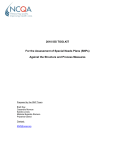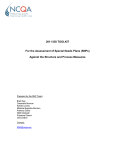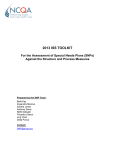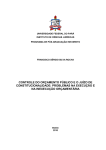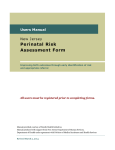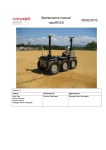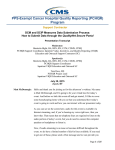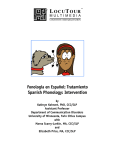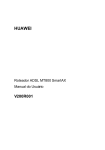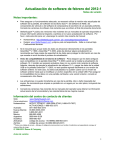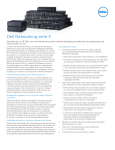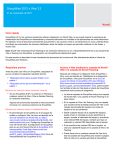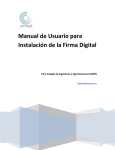Download Revision Updated: June 9, 2009
Transcript
Updated: June 9, 2009 Revisions in Blue 2009 ISS TOOLKIT For the Assessment of Special Needs Plans (SNPs) Against the Structure and Process Measures Prepared by the SNP Team: Brett Kay Casandra Monroe Sandra Jones Melanie Bujanda Romero Priyanka Oberoi Contact: [email protected] 2009 ISS TOOLKIT Table of Contents I. SNP Reporting Key Messages (English) 4 II. SNP Reporting Key Messages (Spanish) 6 III. Reporting Requirements for SNP Type/Element 8 IV. Data Sources by Element 10 V. Guidelines for a Successful Evaluation of a Special Needs Plan (SNP) Against the 2009 Structure & Process Measures 12 VI. Steps and Screenshots for Key Activities 20 VII. ISS Documentation Tips (English) 40 VIII. ISS Documentation Tips (Spanish) 43 IX. ISS Quick Tips for Uploading Documents 45 2 SNP Reporting Key Messages (English) 3 2009 ISS Toolkit - SNP Reporting Key Messages The following key messages are important and should be used to guide you through your organization’s readiness evaluation and the ISS tool submission process. • If your organization has more than one Special Needs Plan (SNP) benefit package, you must submit a separate survey tool for every SNP benefit package. Use the name of the SNP, H-number and plan ID to identify the correct survey tool. • Prepare to submit ISS tool(s) early to avoid internet traffic delays but do not submit your th ISS tool(s) later than June 30 . • Set up each ISS tool by selecting the correct cohort: Cohort I SNP SNP 1 SNP 2 SNP 3 SNP 4 SNP 5 SNP 6 SNP 7 (2:C & 3:B) Operational as of 1/1/07; renewed in 2008 & 2009 X X X X Cohort II Operational as of 1/1/08; renewed in 2009 X X X X X X • Each SNP survey tool has a 1-4 person user license. Your organization’s ISS administrator (this is the person who was sent the tool originally) can give three other individuals access to each of your survey tools. • Do not push the “Submit Survey Tool” button unless your survey tool is complete and you are ready for NCQA surveyors to start the survey process. • You must attach documentation to demonstrate performance for all factors and elements. • Please do not attach documents in zip files or any programs in the Microsoft Office 2007 product suite to the ISS tool. Documents must be saved in the MS 2003 version. • When preparing for a survey please review the S&P measures, FAQs and any policy clarifications NCQA releases updating or clarifying the requirements, since FAQs and policy clarifications are effective upon release (unless noted otherwise). • Plan to highlight sections in your documents that contain evidence for the individual factors and elements, this will help us assess your performance. • Do not include any symbols (i.e. &, #) in the title of the documents when saving them. • If you have any S&P content or SNP reporting questions, the preferable mode of communication is in writing through the Policy Clarification Support (PCS) system. • You can contact the SNP team by e-mailing us at [email protected] SNP Team Contact Information: Brett Kay - [email protected], Casandra Monroe - [email protected], Sandra Jones - [email protected], Melanie Bujanda Romero - [email protected], Priyanka Oberoi [email protected] 4 SNP Reporting Key Messages (Spanish) 5 SNP Mensajes de Clave para Reportar ISS 2009 Los siguientes mensajes de clave son importantes y deben ser utilizados durante la evaluación de su organización y la sumisión del instrumento de ISS. • Si su organización tiene más de un paquete de beneficio de Special Needs Plan (SNP), usted tiene que presentar un instrumento de inspección separado para cada paquete de beneficio de SNP. Use el nombre de SNP, H-numero e ID de el plan para identificar el instrumento de inspección correcto. • Presente el instrumento(s) de ISS temprano para evitar demoras de tráfico de internet pero no presente su instrumento(s) de ISS después del 30 de Junio. • Establezca cada instrumento de ISS por seleccionar la cohorte correcto: SNP Cohorte I Cohorte II Operacional en 1/1/07; Operacional en 1/1/08; renovado en el 2008 y renovado en el 2009 2009 SNP 1 SNP 2 SNP 3 SNP 4 SNP 5 SNP 6 SNP 7 (2:C & 3:B) X X X X X X X X X X • Cada instrumento de la inspección de SNP tiene 1-4 licencia de usuario de persona. El administrador de ISS (esta es la persona que le fue enviado el instrumento originalmente) puede dar acceso al instrumento de inspección a tres individuos. • No presione la tecla de "Somete Instrumento de Inspección " a menos que su instrumento de inspección sea completo y usted está listo para agrimensores de NCQA comiencen el proceso de inspección. • Usted debe conectar documentación para demostrar desempeño para todos los factores y elementos. • Por favor no anexe documentos en archivos de zip ni ningún programa de Microsoft Office 2007 al instrumento de ISS. Use MS 2003. • Cuando estén preparando una encuesta por favor repasen las medidas de S&P, preguntas frecuentes y cualquier comunicados de prensa de NCQA clarificando las pólizas y poniendo al corriente los requisitos, desde que las clarificaciones de póliza de preguntas frecuentes son efectivos desde el momento del los comunicados de prensa (a menos que se indique). • Destacar secciones en sus documentos que contienen evidencia para los factores y elementos individuales, esto nos ayudará a evaluar su desempeño. • No incluya ningún símbolo (es decir &, #) en el título de los documentos de guardar. • Si tiene un pregunta sobre el contenido de S&P o reportes de SNP, el modo preferible de comunicación es por escrito através del sistema de Policy Clarificaction Support (PCS). • Usted puede contactar el equipo de SNP enviando un correo electrónico a [email protected] Información de Contacto del Equipo de SNP: Brett Kay - [email protected], Casandra Monroe [email protected], Sandra Jones - [email protected], Melanie Bujanda Romero - [email protected], Priyanka Oberoi [email protected] 6 Reporting Requirements for SNP Type/Element 7 2009 ISS TOOLKIT – REPORTING REQUIREMENTS BY SNP TYPE/ELEMENT Cohort I** Reporting Required (Y or N) N N N N N N N N Cohort II** Reporting Required (Y or N) Y Y Y Y Y Y Y Y Element A: Assessment of Member Satisfaction Element B: Opportunities for Improvement N N Y Y Measure: SNP 3: Clinical Quality Improvements Element A: Relevance to Members N Y Y Y Y Y Y Y Element A: Monitoring Members’ Health Status Y Y Not for Chronic/Duals Element B: Monitoring Changes in Members’ Health Status Element C: Maintaining Members’ Health Status Measure: SNP 6: Coordination of Medicare and Medicaid Coverage Y Y Y Y Not for Chronic/Duals Not for Chronic/Duals Element A: Administrative Coordination for Dual-Eligible Benefit Packages Y Y Not for Chronic/Institutional Element B: Relationship With State Medicaid Agency for Dual-Eligible Benefit Packages Y Y Element C: Administrative Coordination for Chronic Condition and Institutional Benefit Packages Y Y Not for Chronic/Institutional Not for Duals; *C-SNPs & I-SNPs SEE EXCEPTIONS Element D: Service Coordination Y Y *SEE EXCEPTIONS Measure: SNP 7: New Elements (2C and 3B) Element A: Improving Satisfaction (2C) Element B: Clinical Measurement Activities (3B) Y Y N N Measure/Element Measure: SNP 1: Complex Case Management Element A: Identifying Members for Case Management Element B: Access to Case Management Element C: Case Management Systems Element D: Frequency of Member Identification Element E: Providing Members With Information Element F: Case Management Process Element G: Informing and Educating Practitioners SNP Type Exceptions Measure: SNP 2: Improving Member Satisfaction Measure: SNP 4: Care Transitions Element A: Managing Transitions Element B: Identifying Unplanned Transitions Element C: Reducing Transitions Measure: SNP 5: Institutional SNP Relationship With Facility *EXCEPTIONS (SNPs must provide documentation for any of the following NA scores allowed in Elements 6B, 6C and 6D): - Element 6B is not applicable (N/A) for SNPs in states that do not enter into agreement with SNPs or if state agencies refuse to enter into agreements - Element 6C is not applicable (N/A) for Dual-eligible SNPs. Chronic and Institutional SNPs with fewer than 5% dual-eligible members are not required to report. - Element 6D is not applicable (N/A) for Chronic and Institutional SNPs with fewer than 5% dual-eligible members. ** Cohort Definitions: Cohort I - Operational as of 1/1/07 and renewed in 2008 & 2009; Cohort II Operational as of 1/1/08 and renewed in 2009. 8 Data Sources by Element 9 2009 ISS Toolkit Data Sources by Element SNP SNP 1: Complex Care Management Element A Element B Element C Element D Element E Element F Element G SNP 2: Improving Member Satisfaction Element A Element B SNP 3: Clinical Quality Improvements Element A SNP 4: Care Transitions Element A Element B Element C SNP 5: Institutional SNP Relationship with Facility Element A Element B Element C SNP 6: Coordination of Medicare and Medicaid Coverage Element A Element B Element C Element D SNP 7: Clinical Measurement Activities Element A: (SNP 2C) Element B: (SNP 3B) Data Sources Documented processes OR reports Documented processes OR reports OR materials 1. Documented processes AND screenshots OR 2. Documented processes AND reports, OR access to case management systems Documented processes OR reports Documented processes AND materials Documented processes Documented processes AND materials Reports Reports Reports Documented processes AND reports OR materials Documented processes AND reports Documented processes AND reports OR materials Documented processes AND reports OR materials Documented processes AND reports OR materials Documented processes AND materials Documented processes AND MAY PROVIDE reports OR materials Documented processes OR reports OR materials Documented processes AND MAY PROVIDE reports OR materials Documented processes AND reports OR materials Documented processes AND reports Reports If you would like examples of documented processes, reports or materials, please refer to the Guidelines for a Successful Evaluation of a Special Needs Plan (SNP) Against the 2009 Structure & Process Measures document. 10 Guidelines for a Successful Evaluation of a Special Needs Plan (SNP) Against the 2009 Structure & Process Measures 11 2009 ISS Toolkit: Guidelines for a Successful Evaluation of a Special Needs Plan (SNP) Against the 2009 Structure & Process Measures Welcome to the Structure & Process Measures survey process. The guidelines and resources contained in this appendix will help you prepare for your organization’s survey and maximize the efficiency of your preparation time. SNP Survey Process Readiness Evaluation NCQA’s Web-based Survey Tool for the Evaluation of a Special Needs Plan allows your organization to perform a readiness evaluation at its own pace before submitting data to NCQA. You may assess your program’s operations and evaluate your performance against the Structure & Process Measures. During the readiness evaluation stage, NCQA does not view your information; therefore, you can use the tool to its full capacity and evaluate your organization in a variety of ways. Evaluation by NCQA The NCQA survey process begins with the submission of the Survey Tool which is final upon receipt by NCQA. All Survey Tools are due to NCQA no later than June 30, 2009. If you have specific questions about your preparation contact Customer Service at 888-275-7585, 8:30 a.m.–5:00 p.m. Eastern Time or via e-mail at [email protected]. Preparing for the Readiness Evaluation 1. To facilitate the process, you may find it helpful to keep documents that you link to the Survey Tool in a single directory shared by all your users. This will facilitate multiple users working on the Survey Tool. You can modify, move or rename a linked document, since it is not final until you submit it to NCQA for the evaluation. If you move or rename documents, be sure to update the links in the Survey Tool before your final submission. 2. The Document Library includes a list of all documents linked to your Survey Tool. From here, you can link, unlink or edit documents for any element. Refer to the instructions under the Help tab for detailed information. 12 You can also add documents to the library without linking them to a specific element. This feature allows you to "load" your documents so that they are available in a list of "previously linked" documents that you can access when you need to link a document to an element during your readiness evaluation. NCQA limits the types of documents you may send (See the list of Recommended Supporting Documents at the end of these guidelines.) NCQA encourages you to submit only documents, pages or sections necessary to demonstrate how your organization meets the measures. 3. Download the Supplemental Worksheet for SNP 3A by clicking the Supplemental Worksheet link at the bottom of Element A. Review the instructions and enter the requested data as directed documenting your performance. After completing the worksheet, include a copy of it in the document library and link it to SNP 3 Element A. 4. Cohort I Plans - download Appendix B: Clinical Quality Improvement Projects (QIP) Form Instructions and NCQA QIP Form for SNP 7B (3B). After completing the form, include a copy of it in the document library and link it to SNP 7B (3B). Completing the Survey Tool Print out and use the instructions in the Survey Tool, which you can access by clicking the Help button on the Navigation Bar on the opening screen. The Structure & Process Survey Tool instructions appear on the next screen. They provide all the information necessary to successfully navigate and complete the tool and complete your readiness evaluation. As you assess your performance with each factor and element, be sure to: 1. Preload your document library with essential documents that demonstrate performance against the measures. 2. Evaluate each element and attach the appropriate document(s) that demonstrates performance by linking it to an existing library document or, if necessary, attach a new document by clicking the Link a New Document button. Each factor and element must have supporting documentation. If possible, limit supporting documentation to no more than three documents per element. 13 3. After entering a data element, save it before moving on by clicking the Save button or the Next button. 4. For each supporting document listed, you must: • identify the page number containing the information that supports the factor or element, as specified in the Survey Tool. • attach only pages and sections necessary to demonstrate how your organization meets the measures, as well as any cover page that identifies the document and, if applicable, provides its date. If you reference a document multiple times, you may place the entire document in the document library and reference different pages and paragraphs throughout your assessment. If you wish to stop using the Survey Tool, click on the Log Out button located on the Navigation Bar. You should log out even if you only plan a short break. This will properly notify the system that you are done with your session. If you do not log out, the Survey Tool will “time-out” after 30 minutes of inactivity. Submitting the Survey Tool: Start of the SNP Evaluation Process Upon completion of your readiness evaluation, you will submit the Survey Tool on or before June 30, 2009. Be aware that: After you submit the Survey Tool, you will not be able to change data in the Survey Tool or submit additional materials through the Survey Tool. The Survey Tool is final upon submission. An independent, external surveyor will access the Survey Tool and will perform the assessment. A Plan Comment Period will be incorporated between levels of review in which plans may provide information to clarify issues raised from documentation originally submitted. The turn-around-time for the plan comment period is short; therefore, plans must respond quickly and provide appropriate documentation upon NCQA’s request. NCQA will then conduct a final review of any clarifying information the plan provides along with the surveyor’s assessment and finalize the survey results. 14 NCQA Resources Online Support NCQA’s SNP Web page, www.ncqa.org/snp.aspx, carries a wealth of information that includes recent news from NCQA, the Policy Clarification Support (PCS) system, policy clarifications and updates, and slides and audio recordings of SNP trainings. PCS Send any questions about interpretation of the Structure & Process measures through the PCS system on the NCQA Web site at http://app04.ncqa.org/pcs/web/asp/TIL_ClientLogin.asp. FAQs are available on the SNP page of NCQA’s Web site www.ncqa.org/snp.aspx. FAQs Recommended Supporting Documents Ensure that your documents, policies, procedures, reports and materials address all aspects of each element. The following is a list of documents recommended to attach as evidence of performance so the NCQA surveyor may complete the evaluation of your SNP plan against the Structure & Process measures. The list is not intended to be all-inclusive or prescriptive. Measure SPECIAL NEEDS PLANS SNP 1 SNP 2 Documents* Policies and procedures for identifying members for complex case management Specific criteria used to identify members eligible for complex case management program Scripts or protocols with evidence-based guidelines and automated documentation of contacts Policies or reports that demonstrate frequency with which SNPs systematically identify eligible members for case management Case management procedures Sample case management reports Materials demonstrating how the organization: --provides program information to eligible members that is written and delivered in person or by telephone; and --informs and educates practitioners. Provider manuals, training brochures, information on organization’s website. Reports demonstrating an evaluation of member complaint and appeal data (including how the population was identified, sampling methodology and collection of valid data). Report showing an organization’s analysis of CAHPS results and opportunities for improvement it identified 15 Reports demonstrating identification of opportunities for improvement, actions taken, and sharing of results with practitioners and providers. Organizations with no members at the start of the look-back period may select not applicable (N/A); however, you must provide documentation to demonstrate this. SNP 3 Reports that demonstrate: -- the SNP identified at least three meaningful clinical issues; and -- the SNP selected three clinical measures that are relevant to its membership. ISS tool supplemental worksheet Organizations with no members at the start of the look-back period may select not applicable (N/A); however you must provide documentation to demonstrate this. SNP 4 Policies and procedures detailing the organization’s process for identifying and managing planned/unplanned transitions between care settings. Procedures that demonstrate: --how the SNP communicates changes in members’ conditions to member’s practitioner, member and or responsible party; and --how the SNP educates member and/or responsible party. Policies and procedures for reporting by contracted entities Policies and procedures for case managers to contact members at-risk for a transition and arrange services Reports on daily admissions or staff notification of transitions Reports demonstrating aggregate analysis of transition performance; and -- how the SNP works to reduce transitions For Factor 4 of Element C, organizations with no members at the start of the look-back period may select not applicable (N/A); however you must provide documentation to demonstrate this. SNP 5 Policies and procedures that demonstrate: --how the SNP receives updates from facilities on members care and monitors their health Procedures delineating how the organization and facilities respond to changes in members’ health status and triggering events Contracts or agreements with facilities covering their reporting 16 responsibilities Reports (such as MDS) or materials of how member health status data is collected Job descriptions of staff that visit members and reports they provide on changes in members’ health status Briefing materials distributed by facilities. Elements A, B and C are not applicable (N/A) for Chronic condition and Dual-eligible benefit packages. SNP 6 Policies and procedures that demonstrate how the SNP coordinates Medicaid and Medicare benefits and services Procedures and reports used to determine Medicaid eligibility and changes in members’ Medicaid eligibility. Instructional materials distributed to members or responsible parties on where to reapply for Medicaid. Sample marketing materials, brochures and benefit summaries, Contracts or agreements with the state Medicaid agency; MOU, MOA or letter, legislation/regulation indicating a refusal or inability to act from the state; procedures for administering Medicaid benefits; written notification of a scheduled meeting with state to discuss contracting within the past 12 months; and acknowledgment of receipt of instructional materials from state on how to administer Medicaid benefits. Job descriptions, procedures and scripts used by staff that assist members with information on Medicare and Medicaid: eligibility, benefits and claims Policies and procedures for arranging services for members along with provider directories, provider manuals. Reports on accessibility of Medicare and Medicaid practitioners and providers Elements 6A and 6B are not applicable (N/A) for Chronic condition and Institutional benefit packages. Element 6B is not applicable (N/A) for SNPs in states that do not enter into agreement with SNPs or if state agencies refuse to enter into agreements; however, you must provide documentation to demonstrate this. Element 6C is not applicable (N/A) for Dual-eligible SNPs. Chronic and Institutional SNPs with fewer than 5% dual-eligible members are not 17 required to report; however, you must provide documentation to demonstrate this. Element 6D is not applicable (N/A) for Chronic and Institutional SNPs with fewer than 5% dual-eligible members; however, you must provide documentation to demonstrate this. SNP 7A (2C) Reports that show: --an analysis of satisfaction data and opportunities identified for SNP 2A and 2B or a new analysis of satisfaction data. Reports that demonstrate: --the implementation of the intervention; and --an assessment to determine the impact of the intervention Documented processes describing how the organization will evaluate the effectiveness of the intervention(s). Organizations with no members at the start of the look-back period may select not applicable (N/A); however you must provide documentation to demonstrate this. SNP 7B (3B) Documented process or reports that demonstrate: --the SNP collected data on all measures identified in SNP 3A (or new measures identified) and how it is relevant to SNP members; --performed a quantitative and qualitative analysis on each measure; and --identified opportunities the SNP decided to pursue. QIP or QIA Form that includes: a quantitative analysis, comparison of results with goal or benchmark or past performance; and a qualitative analysis which identifies reasons for results and potential barriers. Organizations with no members at the start of the look-back period may select not applicable (N/A); however you must provide documentation to demonstrate this. *For those using more recent versions of Microsoft Office products, documents should be saved as 2003 versions. For security reasons, including the protection of the data and documents you send to us, we limit the types of documents you may send. The permitted file types are .CSV, .DOC, .GIF, .JPG, .MPP, .PDF, .PPT, .RTF, .TIF, .TXT, .VSD and .XLS. We cannot accept files in other formats. Please note that most other formats can be converted to .GIF, .TIF, or .JPG via scanner, or to PDF using Adobe® Acrobat®. ** Please do no send documents that contain Protected Health Information (PHI). 18 Steps and Screenshots for Key Activities 19 2009 SNP ISS Toolkit – Steps and Screenshots for Key Activities This section of the toolkit summarizes and illustrates steps and information organizations can use to perform certain activities in their ISS survey tools. It provides a quick reference for: logging into survey tools, changing passwords, adding documents to the library; uploading documents to your server and conducting completeness checks. Please consult the Interactive Survey System User’s Manual in ISS for complete instructions and details on all ISS survey tool functions. Getting started: NCQA gives the Administrator for each SNP a temporary user ID and password which prompts the user to change the password the first time it is used. Administrators should store their password in a safe place since they can grant up to 3 additional users access to the organization’s survey tools. 1) Go to https://iss.ncqa.org (you may want to bookmark this page) 2) Enter the user ID and password (passwords are case sensitive) 3) Click log-in 4) Accept the license agreement (access is not permitted if you do not accept) 5) Welcome page (picture of Peggy O’Kane) 6) 10) Administrators may manage users via Administrative Functions or Change User Password (screenshots 1A and 1B) (see full instructions in User Manual) Select the appropriate survey tool by clicking on 2009 SNP S&P to enter the tool (screenshot 2A) Click on the Help and Instructions tab for complete instructions or a Users’ Manual (screenshot 3A) You must set up your survey tool by selecting the appropriate cohort for the SNP before you can work in ISS. Setting up your survey tool: (a) Click Set-up Survey Tool (screenshot 4A); (b) Click Select Evaluation Options (screenshot 4B) (c) Select Cohort (I or II); (d) Select for Readiness Evaluation; (e) click Save; (f) close window to return to SNP page (screenshot 4C) On Navigation Bar, click Organization Background tab and complete (screenshot 5A) 11) Click Survey Tool to return to SNP page (screenshot 6A) 7) 8) 9) Top Navigation Bar includes ISS functions Blue Navigation Bar includes contents of the S&P measures 12) Click the SNP Tab/Select the Measure or Element to begin readiness evaluation (screenshot 6B) Tip: If you have selected the appropriate cohort, you will be allowed to populate answers for the Measures and Elements assigned to that cohort. (screenshot 7A) 13) You can add a document in ISS directly from an element or by going into the Document Library; however the following instructions are for adding documents from the Document Library. To add documents: (a) click Document Library; (b) click Add Document to the Library, a form appears that contains fields you must complete entitled Document name and Document file path; (c) use the Browse button to launch a file “look-in” prompt of your local drives; (d) locate the document and select it using the Open button located on the file “look-in” prompt; (e) scroll over the name of the document only – not the entire path; (f) copy and paste the name of the 20 document into the Document name field; (g) click Save or Save and attach more documents. (screenshots 8A and 8B) Tip: We recommend that you browse to the document since the name and file path must match exactly and typing this information could introduce typing errors (screenshot 8C) Tip: If your documents are in versions of Microsoft Word, Excel etc. later than 2003, please save back to the 2003 versions before adding them to the document library. Tip: Ensure that document titles do not contain any special characters or symbols (e.g., -, _, #, & etc.) 14) Remember to link documents to the appropriate element(s) in the Document library. Linking a document to an element: (a) Click Link to New Element to link documents; (b) enter the page number(s) in Reference Pages; (c) select the Relevance level from the available options; (d) select the element to which you want to link the document to; (e) click Save or click Save and Link More Elements if you would like to link this document to more elements; (f) click Save. (screenshots 8D and 8E). To link another new document to an element repeat steps (a) through (e). 15) To upload documents: (screenshots 9A, 9B, 9C and 9D) (You may also wish to refer to Quick Tips for Uploading Documents.) (a) From the Survey Tool page click Upload Documents; (b) the Documents verification and upload window will appear/maximize window; (c) scroll down to view documents. (d) Under the Supporting Documents for the Survey Tool header, you will see the: Document Name, Document File Path, Referenced in Elements, Verify Document Path, Upload Complete and Remove from Server fields. (e) complete the Verify Document Path field by Browsing to document file path (recommended) or by copying and pasting it; (f) after browsing select the file path and open it from the file look-in menu; (g) click Upload Document. (h) The page will refresh – “Yes” will appear under Upload Complete and file path will move if the upload is successful. (i) You must verify the path and upload each document. (j) Please upload documents periodically in batches. To remove documents: (a) Select the checkbox under the Remove document from server field; (b) click Remove Documents from Server button at the bottom of page; (c) click OK in the dialogue box – “No” will appear if removal is successful; (d) click return to Survey Tool when you have completed uploading the documents. Tip: Always logout when you are finished working on your ISS tool (screenshot 10A) 16) Perform a completeness check before you submit your survey tool. To check completeness: (screenshot 11A and 11B) (a) Click Survey Tool followed by Utilities; (b) Select the Completeness check link; (c) Review the Evaluation Option selections; (d) double check each element and complete all that are listed as incomplete. 17) To submit survey tool(s): After you have confirmed all information in the survey tool is accurate and you are ready to submit, (a) Click on Set-up the Survey Tool followed by Select Evaluation Options; (b) Mark the checkbox for your cohort under “Select to Submit for Survey” and save (screenshots 12A and 12B); (c) click on the Submit Final Survey Tool link on the Top Navigation Bar (screenshot 12C); (d) confirm that you are ready to submit your final Survey Tool. This is the last chance you have to cancel the final submission of your Survey Tool. (e) Click ok to submit your Survey Tool for survey. Once submitted, you will receive a confirmation and have access to a "read only" copy of your submitted Survey Tool (screenshot 12D). 21 Screenshot 1A Change Password The ISS tool gives you the option to change your password. Screenshot 1B Change Password 22 Screenshot 2A Welcome (License) Select the 2009 SNP Structure & Process link to enter the ISS tool 23 Screenshot 3A Help & Instructions Help & Instructions tab can assist you in navigating the ISS tool. 24 Screenshot 4A Survey Tool Select the Setup Survey Tool to select the SNPs cohort. Screenshot 4B Setup Survey Tool Click on the Select Evaluation Options link. 25 Screenshot 4C Select Survey Cohort Select your SNP’s cohort 26 Screenshot 5A Organization Background Please write a short description of the SNP The organization can attach additional documents 27 Screenshot 6A Enter Survey Tool Click on the SNP tab to enter the ISS tool Screenshot 6B ISS tool You are now in the ISS Tool 28 Screenshot 7A ISS Tool- Standard If you did not set up your tool by selecting a cohort you will not see the “Yes”or “No” options (as shown on the left) Cohort I – SNP 4-7 Cohort IISNP 1-6 29 Screenshot 8A Document Library Click on Document Library tab to add and link documents Screenshot 8B Document Library- Browse Documents Add pertinent documents to the document library. 30 Screenshot 8C Document Library- Add Documents Locate documents by browsing to find them. More information included in the ISS steps. Screenshot 8D Document Library- Link Documents Link documents to relevant elements. 31 Screenshot 8E Document Library- Link Document to Element Make sure to select the element you are linking the document to and save. 32 Screenshot 9A Upload Documents Upload your documents by selecting the upload documents option. Screenshot 9B Upload Document Verify document file path 33 Screenshot 9C Upload Documents You will see a “Yes” confirmation for a successful upload Click “Upload Documents” Screenshot 9D Additional Example 34 Screenshot 10A Logout Always logout when you are finished working on your ISS tool. 35 Screenshot 11A Utilities – Completeness Check Utilities Tab After you are finished completing the tool, please click on the Utilities tab and check your ISS tool completeness. Screenshot 11B Utilities – Completeness Check Completeness check: Elements that are not complete will appear. 36 Screenshot 12A Submit- Setup Survey Tool Cohort When you are ready to submit your ISS tool, click Setup Survey Tool followed by select evaluation options. Screenshot 12B Submit- Select Cohort Click the appropriate cohort in the select to submit for survey section and save. 37 Screenshot 12C Submit Next click on Submit Survey Tool Screenshot 12D Submit Confirmation A project number for the survey is assigned. 38 ISS Documentation Tips (English) 39 1 2 3 ISS Documentation Tips 4 5 6 7 8 9 10 11 12 13 14 15 16 17 18 19 20 21 22 23 24 25 26 27 28 29 30 31 32 33 34 35 36 37 38 39 40 41 42 43 44 • Maintain documents on a shared drive. • Consider creating folders for each standards Structure and Process Measure. • Establish a system for version control. • Name documents clearly – your audience is both internal staff and surveyors. • Avoid characters such as ampersand (&) or apostrophe (‘). • Avoid duplicate names. • Use common file types such as: .doc (Word documents); .xls (Excel documents); .ppt (Power Point); .pdf (Adobe PDF); .gft; .jpg. • Do not send .exe (executables). • Documents that you don’t have electronically can be scanned and converted to PDF, GIF, or JPG. • Don’t scan everything – this creates large files that may be challenging for you to upload and for the surveyors to open. • Consider making your final Word or Excel documents “read only” to ensure no changes will be made. • Try using legal line numbering as on the left of this page to identify areas that demonstrate compliance.* (remember: this may change your pagination) • Highlight key sentences or areas of your documents to call the surveyor’s attention to that area. 40 45 46 47 48 49 50 51 52 53 54 55 56 57 58 59 60 61 62 63 64 65 66 67 68 69 70 71 72 73 74 75 76 77 78 79 80 81 82 83 84 85 • Insert a hyperlink if necessary to demonstrate compliance by either copying the URL: https://iss.ncqa.org/RDSat/ATLogin.asp or by using the “Insert” function of Word or Excel. • Label drafts and final documents carefully to be able to distinguish between them. • Use the date feature in footers to keep track of last time you updated the document. • Linked documents can be edited but remember that may change page reference numbers. • Uploaded documents (those already transferred to NCQA servers) cannot be edited. Prior to submission, if you need to edit a document uploaded to the NCQA server, you must remove, edit and re-upload it. After submission, you may not edit uploaded documents. *Directions for legal line numbering in Word: 1. On the File menu, click Page Setup, and then click the Layout tab. 2. If you're adding line numbers to part of a document, click Selected text in the Apply to box. 3. Click Line Numbers. 4. Select the Add line numbering check box, and then select the options you want. 41 ISS Documentation Tips (Spanish) 42 1 2 3 4 5 6 7 8 9 10 11 12 13 14 15 16 17 18 19 20 21 22 23 24 25 26 27 28 29 30 31 32 33 34 35 36 37 38 39 40 41 42 43 44 45 46 47 48 49 50 51 Consejos para los documentos de ISS • Mantenga documentos en un camino compartido • Considere carpetas para cada categoría de estándares • Establezca un sistema para el control de versión • Establezca un nombre claramente para el documento - su audiencia es ambos internos personal y agrimensores • Evite caracteres como el signo (&) o el apóstrofo (‘) • Evite nombres de duplicado • Utilice archivos comunes como: .doc (Word); .xls (Excel); .ppt (Power Point); .pdf (Adobe PDF); .gft; .jpg. • No mande .exe (Executables) • Documentos que no tienen electrónicamente, pueden ser escaneados y convertidos en PDF, GIF, o JPG. • No debe escanear todo- esto causa que los documentos sean muy grandes y puede ser un reto para que usted cargue y para que el agrimensor abra el documento. • Considere hacer los documentos finales de Word y Excel “Sólo Lea” para asegurar que ningunos cambios serán hechos. • Intente numerar el documento (como a la izquierda de esta página) para identificar áreas que demuestran conformidad. • Destaque oraciones o áreas de clave en sus documentos para llamar la atención del agrimensor a esa área. • Inserta un hiperenlace si es necesario para demostrar conformidad por o copiar la url: https://iss.ncqa.org/RDSat/ATLogin.asp o por utilizar la función de “Insert” de Word o Excel. • Etiquete el borrador y la copia final para distinguir entre ellos. • Utilice la característica de la fecha al final de la página para asegurar la última vez que hizo cambios al documento. • Los documentos ligados pueden ser redactados pero recuerdan que eso puede cambiar números de referencia. • Los documentos cargados (esos ya transferidos a servidores de NCQA) no pueden ser redactados. Antes de sumisión, si usted necesita redactar un documento cargado al servidor de NCQA, usted debe quitar el documento, redactar y descarga lo. Después de sumisión, usted no pueda redactar documentos cargados. 43 ISS Quick Tips for Uploading Documents 44 INTERACTIVE SURVEY SYSTEM Quick Tips: Uploading Documents NCQA’s Interactive Survey System is designed to make the process of transferring your survey documentation to NCQA easy and secure. But depending on factors such as the size of those documents, the speed of your server and network conditions, the upload process may take several hours. The following facts, tips and guidelines will help make sure that your documentation makes it to NCQA on time and with a minimum of hassle. • Upload early. Upload often. It’s never too early to upload completed documents. Uploading documents is not the same thing as submitting the Survey Tool (ST) and starting your S&P assessment. You can visit the upload screen as often as you wish before hitting the “Submit Final Survey Tool” button. If a document you have already uploaded to the ISS server needs to be updated or replaced, no problem. Simply resend the updated document with the same file name. The ST will only use the latest version; you can add or delete documents from the ISS server before you submit. • Document “bulk” will affect your upload times. “Bulk” is NCQA’s term for the total size, in kilobytes, of all your organization’s supporting documents. For example, ten 200-kilobyte documents have the same “bulk” as one 2-megabyte document. Your upload times will be determined, in large part, by your document bulk. • Your network and server capability will affect upload times, too. Every network is different; yours may be extremely fast, allowing you to upload several documents at once without concern. But if that’s not the case, you might consider uploading during off-peak hours. • Your Privacy is Paramount. It’s in the License Agreement. NCQA stores documents on a dedicated, high security server only accessible to our IT staff for maintenance. Surveyors are prohibited from seeing documents until you submit you final ST and the assessment starts. • The “Document Upload” option will be added to the main navigation bar. If you’re already using the ISS, you know that the document upload link is found under “Submit Survey Tool” on the black navigation bar. The “Upload Documents” option can also be found on the main navigation bar, saving users a click when it’s time to upload documents. • Be certain you’re set to go before you submit your final ST. Prior to submitting your Survey Tool, use the “Completeness Check” to be sure you’ve filled out all the portions of your Survey Tool the Structure and Process Measures call for. The “Completeness Check” can be found under the “Utilities” section. “THE ISS MAKES managing the survey process easier from start to finish.” Kathy Barfoot, National Manager of Accreditation, UnitedHealthcare 45 ISS Upload Guidelines 1. Test the process! It’s critical to confirm that your documents will be received by NCQA. The test will give you an idea of how quickly your documents will upload. 2. Start early. Send documents when they are complete. Don’t wait until your submission date! 3. Send documents in bunches. NCQA recommends uploading documents in groups of 2 to 5; large documents should be sent singly. Start with small documents before moving to those with more “bulk.” 4. Copy your documents from your network to your hard drive, and upload from there. This will significantly increase the likelihood of a successful submission. Note: you do not have to change the ST references to the document location if you do this. 5. Upload during off-peak hours. The Internet and your network both have rush hours, too—traffic moves more slowly when everyone’s on the “information superhighway.” Plan accordingly! 7585. 46














































